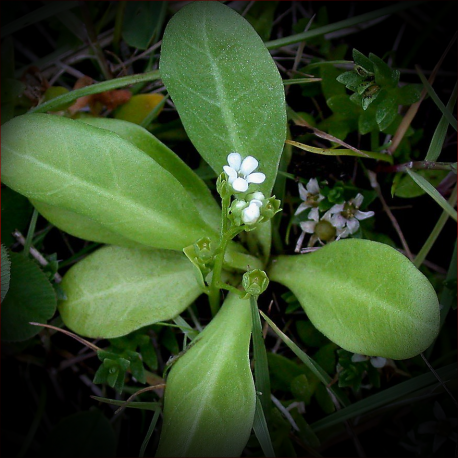More info
Datasheet
| Aquarium Compatible | yes |
| Plant Outdoor | yes |
| Plant Emersed Growth | yes |
| Plant Growth | slow |
| Temperature Tolerance | 4°C / 39.20°F - 35°C / 95.00°F |
| Temperature | 22°C / 71.60°F - 26°C / 78.80°F |
| Carbonate Hardness | 7-30 kh |
| pH Value | 6-9 ph |
| Light | medium-high |
| Carbon Dioxide (CO2) | 5-40mg/lmg/l |
| Nitrate (NO3-) | 10-50mg/lmg/l |
| Phosphate (PO43-) | 0.1-3mg/lmg/l |
| Potassium (K+) | 5-30mg/lmg/l |
| Iron (Fe) | 0.01-0.5mg/lmg/l |
General Description
Seaside rivuletweed, also known as Samolus valerandi, is a small bog plant that can be found in various parts of the world. It thrives in wet environments, both in fresh and brackish water. The plant features light green spreading leaf rosettes that reach a height of about 15 cm. The leaves are oblong in shape and resemble lamb's lettuce, with rounded tips and margins running down along the leaf stalk. When grown emersed, the plant produces flower stalks that can grow up to 50 cm in height, bearing small white flowers and round capsules containing numerous tiny seeds.
Aquarium Suitability
Water pimpernel is suitable for aquariums and is frequently available commercially. It is considered a midground or foreground plant and can be used in nano tanks or in groups to create a visually appealing aquascape.
Demands and Hardiness
This plant has a medium difficulty level and grows slowly. It can tolerate colder temperatures, making it suitable for various aquarium setups. For specific water conditions and requirements, refer to the provided table.
Aquascaping & Usage
Water pimpernel can be utilized in aquascaping to add a touch of greenery to the midground or foreground of the aquarium. Its compact size and slow growth make it ideal for nano tanks or for creating lush groupings in larger setups.
Propagation
Propagation of Samolus valerandi can be done through seeds, splitting, or cutting off daughter plants. This plant offers aquarists multiple options for expanding their aquatic garden.
Habitat and Distribution
In its natural habitat, Seaside rivuletweed can be found in wet areas on the shores of both fresh and brackish water bodies. In Central Europe, it grows in brackish reeds near the coast, among other locations. The plant's adaptability to different water conditions contributes to its widespread distribution across various regions.

